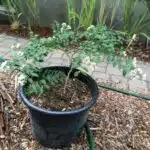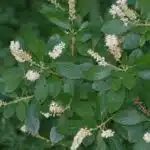Blue Blossom Ceanothus, also known as California Lilac, is a stunning flowering shrub native to the western United States. Its vibrant blue flowers and glossy green leaves make it a popular choice for gardeners looking to add color and texture to their landscapes. While this plant is relatively easy to grow, it does require specific care and attention to thrive.
As a horticulture specialist, I am often asked about the best methods for growing Blue Blossom Ceanothus. In this article, I will share my expert knowledge on how to cultivate this beautiful plant successfully. Whether you are an experienced gardener or just starting with your first garden, these tips will help you grow healthy and vibrant Blue Blossom Ceanothus plants that will enhance the beauty of your landscape. So let’s dive in and learn how to grow Blue Blossom Ceanothus!
Understanding Blue Blossom Ceanothus
Blue blossom ceanothus, also known as Ceanothus thyrsiflorus, is a stunning shrub that belongs to the buckthorn family. This evergreen plant is native to California and Oregon, where it thrives in warm and dry climates. It can grow up to 10 feet tall and wide, making it an ideal choice for hedges or borders. The blue-violet flowers of this plant bloom in the spring and summer, attracting bees and butterflies.
To ensure that your blue blossom ceanothus grows healthy and strong, it is important to understand its pruning techniques. This shrub requires minimal pruning, with most of the trimming done during the early spring season. Start by removing any dead or diseased branches using a clean pair of pruning shears. You can also prune back any overgrown branches to maintain the desired shape of your shrub.
The soil pH levels play a crucial role in the growth of blue blossom ceanothus. These plants prefer well-draining soil with a pH level between 5.5 and 7.5. If your soil is too acidic, you can add lime to raise its pH level. Conversely, if your soil is too alkaline, you can add sulfur or peat moss to lower its pH level. By ensuring that your soil has the right pH balance, you can help your blue blossom ceanothus thrive and produce beautiful blooms year after year.
To choose the right location for planting your blue blossom ceanothus, you must consider several factors such as sunlight exposure, water availability, and temperature conditions.
Choosing The Right Location
Location is a crucial factor in the successful growth of blue blossom ceanothus. This plant requires full sun exposure, which means it needs at least 6 hours of direct sunlight per day. Therefore, it is essential to choose a spot that receives enough sunlight throughout the day. Insufficient sunlight can lead to poor growth and even death of the plant.
Another important factor to consider when choosing a location is soil type. Blue blossom ceanothus thrives in well-draining soil that is rich in nutrients. It does not tolerate heavy clay or poorly drained soils. To ensure optimal growth, it is recommended to test the soil before planting and amend it accordingly with organic matter such as compost or aged manure.
In addition to sun exposure and soil type, the location should also be protected from strong winds and extreme temperatures. Strong winds can damage the delicate branches and flowers of blue blossom ceanothus, while hot temperatures can cause stress on the plant’s roots. Therefore, planting in an area where there is some natural protection from wind and temperature extremes will help ensure your plants’ success.
- Before planting blue blossom ceanothus, assess your garden’s sun exposure to determine if you have adequate light for this species.
- Test your soil type for drainage capacity and levels of fertility necessary for optimal growth.
- Consider natural protection from wind gusts and extreme temperatures when selecting a location for planting blue blossom ceanothus.
With these factors in mind, you can select an appropriate location for your blue blossom ceanothus that will provide sufficient sun exposure, proper soil conditions, and natural protection from wind gusts and heat waves required by this species for healthy growth. The next step involves preparing the soil to create optimal growing conditions for this shrub.
Preparing The Soil
After selecting the ideal location for your blue blossom ceanothus, it is essential to prepare the soil. The first step in preparing the soil is to remove any weeds or debris from the area. This will prevent competition for nutrients and allow your plant to grow healthily.
The next step is to test the soil pH level. Blue blossom ceanothus thrives in a slightly acidic to neutral soil pH range between 6.0-7.5. If the pH level is too high or too low, amendments may be necessary to adjust it accordingly. It is recommended to use organic materials such as compost or aged manure to improve soil fertility and structure.
Additionally, blue blossom ceanothus requires well-draining soil. To achieve this, you can add sand or perlite into the mixture at a ratio of 1:3 with topsoil or potting mix. Once you have prepared the soil correctly, you can proceed with planting your blue blossom ceanothus and provide adequate water and nutrient requirements for optimal growth.
To plant blue blossom ceanothus successfully, it is crucial to follow proper planting techniques and provide regular maintenance. In the subsequent section, we will discuss how to plant and care for your blue blossom ceanothus effectively.
Planting Blue Blossom Ceanothus
Planting Blue Blossom Ceanothus is an exciting and rewarding task for garden enthusiasts. The first step in planting this shrub is to select a suitable location that receives full sunlight. Blue Blossom Ceanothus thrives in areas with plenty of light, so it is essential to choose a spot that gets at least six hours of direct sunlight daily.
Before planting, prepare the soil by removing any debris and weeds from the area. Blue Blossom Ceanothus prefers well-drained soil, so adding compost or sand can improve drainage. Once the soil preparation is complete, dig a hole twice as wide as the root ball and deep enough to accommodate its size. Place the shrub in the hole and backfill it with soil while gently pressing it down.
After planting, watering frequency is critical for Blue Blossom Ceanothus’s growth and survival. This shrub requires regular watering until it establishes itself in the ground. Water frequently during hot weather and dry spells to maintain healthy growth. However, avoid overwatering or allowing water to pool around the roots as this can lead to root rot. In the next section, we will discuss watering and fertilizing requirements in more detail for optimum plant health.
Watering And Fertilizing
How often should you water and fertilize your blue blossom ceanothus? This is a question that many gardeners ask themselves when growing this beautiful plant. The answer is not straightforward, as it depends on several factors such as the climate, soil type, and age of the plant.
Watering techniques for blue blossom ceanothus should be adjusted according to the season. During the summer months when temperatures are high, watering should be more frequent to prevent the soil from drying out completely. In contrast, during cooler seasons like fall or winter, watering can be reduced to once every two weeks or even less frequently. To ensure that your blue blossom ceanothus receives sufficient water, aim to keep the soil evenly moist but not saturated.
Fertilizing frequency also depends on several factors such as the age of the plant and soil quality. Young plants require more frequent fertilizing than mature ones since they are still developing their root system. Fertilizing should be done during the growing season with a balanced fertilizer with an equal amount of nitrogen, phosphorus, and potassium. Fertilizer application rate should follow manufacturer instructions to avoid over-fertilization which can lead to root burn.
When it comes to caring for your blue blossom ceanothus, proper watering and fertilizing are crucial components for keeping your plant healthy and vibrant. By following these guidelines and adjusting them according to your specific conditions, you’ll have a lovely addition to your garden that will thrive for years to come.
Moving forward in pruning and maintenance of blue blossom ceanothus requires careful consideration of various factors such as timing of pruning, appropriate tools for pruning based on stem size and thickness among other things.
Pruning And Maintenance
After properly watering and fertilizing your blue blossom ceanothus, it is time to turn your attention to pruning and maintenance. Pruning techniques vary depending on the type of ceanothus you have, but generally involve removing dead or damaged branches and shaping the plant. This should be done in late spring or early summer after the plant has finished blooming for the season.
Timing of maintenance is also important for the overall health and appearance of your blue blossom ceanothus. Regularly inspecting the plant for signs of pests and disease, as well as removing any weeds around its base, will help keep it healthy. In addition, it is recommended to give your ceanothus a light pruning each year to encourage new growth and maintain its shape.
By following proper pruning techniques and timing of maintenance, you can ensure that your blue blossom ceanothus remains healthy and vibrant for years to come. However, even with proper care, common pests and diseases can still afflict these plants. In the next section, we will discuss how to identify and deal with these issues so that you can continue to enjoy your beautiful ceanothus.
Dealing With Common Pests And Diseases
- Accurately identifying pests and diseases is an essential first step in preventing and resolving pest and disease issues in blue blossom ceanothus plants.
- Common pests and diseases of blue blossom ceanothus can be categorized as either fungal, bacterial, viral, or insect-based.
- Treatment of pests and diseases of blue blossom ceanothus typically involves a combination of cultural, physical, and chemical techniques in accordance with the species and severity of the problem.
- In order to most effectively and efficiently treat pests and diseases in blue blossom ceanothus, proper identification and monitoring of the issue is key.
Identifying Pests And Diseases
As a horticulture specialist, it is important to identify pests and diseases that may affect the growth of blue blossom ceanothus. These plants are susceptible to various types of pests, including spider mites, scale insects, and thrips. Spider mites can cause damage by sucking the sap from plant leaves, leading to yellowed and shriveled foliage. Scale insects can also drain sap from the plant and secrete a sticky substance that attracts other pests. Thrips feed on flowers and leaves, causing distorted growth.
To prevent these pests from infesting blue blossom ceanothus, it is essential to maintain proper plant care practices such as regular watering and fertilization. It is also important to keep an eye out for any symptoms of pest infestations, such as discoloration or abnormal growth patterns. In case of infestation, treatment options include using insecticidal soap or neem oil to control spider mites and scale insects. For thrips, introducing beneficial insects like ladybugs or lacewings can help control their population.
Diseases can also affect the growth of blue blossom ceanothus. Root rot caused by overwatering or poor drainage is a common issue that affects the root system of these plants. To prevent this disease from occurring, make sure to provide proper drainage for the soil and avoid overwatering. Leaf spot disease caused by fungal infections can cause brown spots on leaves which eventually drop off. Treatment options include pruning affected branches and using fungicides if necessary. Identifying these diseases early on will allow for prompt prevention methods or treatment options to be implemented effectively.
Treating Pests And Diseases
As a horticulture specialist, treating pests and diseases is an essential aspect of plant care. When it comes to blue blossom ceanothus, there are various pests and diseases that can affect the growth of these plants. It is important to identify these issues early on and take prompt action to prevent them from causing irreversible damage.
Treating pests and diseases in blue blossom ceanothus can involve both chemical and natural remedies. For example, insecticidal soap or neem oil can be used to control spider mites and scale insects. However, introducing beneficial insects like ladybugs or lacewings can also be effective in controlling the population of thrips. Additionally, prevention tips such as maintaining proper watering and fertilization practices can help reduce the risk of pest infestations.
In terms of disease treatment, pruning affected branches can help control the spread of leaf spot disease caused by fungal infections. Prevention tips like providing proper drainage for the soil and avoiding overwatering can also help prevent root rot from occurring. Additionally, using fungicides may be necessary in severe cases. By being proactive in treating pests and diseases through a combination of natural remedies and prevention tips, blue blossom ceanothus plants can thrive with healthy growth patterns for years to come.
Propagating Blue Blossom Ceanothus
Propagation methods for Blue Blossom Ceanothus involve both sexual and asexual methods. Sexual propagation is achieved through seed germination, while asexual propagation can be done through stem cuttings. Stem cuttings are the most common method of vegetative propagation for this species. Cuttings should be taken in early summer when the plant is actively growing, and the cutting material should be taken from the current season’s growth.
To propagate Blue Blossom Ceanothus through stem cuttings, select healthy shoots that are 4 to 6 inches long and have at least two sets of leaves. Remove the lower set of leaves, leaving only one set at the top of the cutting. Dip the base of each cutting into rooting hormone powder and plant it in moist potting soil or perlite. Keep the soil moist but not waterlogged and place in a bright, warm location with indirect sunlight.
Rooting hormone application is essential when propagating Blue Blossom Ceanothus from cuttings because it stimulates root growth. A rooting hormone helps to speed up root development by providing hormones that stimulate cell division and elongation in developing roots. By applying rooting hormone to your Blue Blossom Ceanothus cuttings, you increase their chances of successful propagation. Once rooted, transplant your new plants into larger containers or directly into your landscape design for their stunning blue blooms to enhance your garden’s aesthetic appeal.
Incorporate these beautiful flowering shrubs into your landscaping design by placing them as an accent plant or using them as a backdrop for other colorful flowers or foliage plants. Their vibrant blue flowers make for an excellent complement to yellows, oranges, pinks, purples, and greens found in other plants commonly used in landscaping designs. Whether you choose to use them as single specimens or mass plantings, adding Blue Blossom Ceanothus will bring natural beauty to your garden year after year without much care required.
Using Blue Blossom Ceanothus In Your Landscape Design
Having successfully propagated blue blossom ceanothus, it’s time to start incorporating this stunning plant into your landscape design. With its vibrant blue flowers and evergreen foliage, blue blossom ceanothus is an excellent addition to any garden. Here are some design tips and color combinations to consider when using blue blossom ceanothus in your landscape.
Firstly, blue blossom ceanothus is an excellent choice for Mediterranean-style gardens. Its drought-tolerant nature and ability to thrive in sandy soil make it a perfect fit for these types of gardens. Additionally, try planting it alongside other Mediterranean plants like lavender or rosemary for a cohesive look.
Secondly, blue blossom ceanothus pairs well with other plants that have contrasting foliage color or texture. For example, try planting it next to red-leafed plants like Japanese maple or smoke bush for a striking contrast in colors. Alternatively, you can also pair it with plants that have different textures such as ornamental grasses or succulents.
Lastly, when designing with blue blossom ceanothus, keep in mind the plant’s size and growth habit. It’s essential to give the plant enough space to grow without overcrowding other plants nearby. Also, consider pruning the plant regularly to maintain its shape and prevent it from getting too leggy.
Designing with blue blossom ceanothus allows gardeners to create beautiful and vibrant landscapes that are sure to impress visitors. By following these design tips and exploring different color combinations, you’re sure to create a stunning outdoor space that incorporates this fantastic plant seamlessly.
As you begin incorporating blue blossom ceanothus into your landscape design, you may have some questions about caring for this unique plant variety. In the next section, we’ll cover frequently asked questions about blue blossom ceanothus and offer expert advice on how best to care for this lovely plant species.
Frequently Asked Questions About Blue Blossom Ceanothus
Imagine a beautiful painting, with vibrant blue hues and a touch of green. This is what your garden could look like with the addition of blue blossom ceanothus. This plant is a favorite among horticulture enthusiasts due to its stunning visual appeal and easy care. In this section, we will discuss some frequently asked questions about blue blossom ceanothus to help you grow it successfully.
Blue blossom ceanothus care is relatively simple. This plant prefers well-drained soil and full sun exposure but can tolerate some shade. It does not require frequent watering once established, making it an excellent choice for low-maintenance gardens. However, it is crucial to ensure that the soil does not dry out completely during hot summer months.
When it comes to pruning techniques for blue blossom ceanothus, it is best to prune after flowering has ended. You can remove any dead or diseased branches and shape the plant as desired. Avoid cutting back more than one-third of the plant’s growth as this may affect its overall health. For planting advice, choose a location that receives plenty of sunlight and has well-draining soil. Add compost or organic matter to the soil before planting for added nutrients.
Propagation methods for blue blossom ceanothus include taking cuttings in late spring or early summer from new growth that has not yet hardened off completely. Dip the cuttings in rooting hormone powder before placing them in moist potting soil or sand mixtures. Keep them in a warm area with indirect sunlight until roots have formed, then transplant into larger containers or directly into the ground.
In summary, growing blue blossom ceanothus requires minimal effort while providing maximum visual impact in your garden. By following these tips and tricks on care, pruning techniques, planting advice, and propagation methods, you can enjoy this beautiful plant for years to come!
Conclusion
Blue Blossom Ceanothus is a beautiful and hardy plant that can add an attractive burst of color to your garden. As a horticulture specialist, I have seen how this plant can thrive in various environments, but it does require some specific care to grow successfully.
To grow Blue Blossom Ceanothus, it’s essential to choose the right location for planting. This plant grows best in full sun exposure and well-draining soil. Before planting, ensure that the soil is adequately prepared with enough organic matter and nutrients to support healthy growth.
Once planted, watering and fertilizing regularly are critical to keeping your Blue Blossom Ceanothus healthy. However, be mindful not to overwater or over-fertilize as this can damage the plant. Additionally, keeping an eye out for common pests and diseases such as aphids or powdery mildew is essential for maintaining its longevity.
In conclusion, growing Blue Blossom Ceanothus can be a delightful addition to any garden or landscape design. With proper care and attention to detail, this plant can flourish and bring joy for years to come. As the saying goes, “A garden requires patient labor and attention. Plants do not grow merely to satisfy ambitions or fulfill good intentions; they thrive because someone expended effort on them.” Let us take inspiration from this metaphor and put in the required work needed to make our gardens bloom with beauty!
Image Credits





























